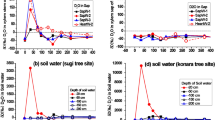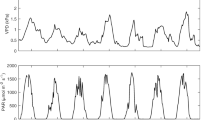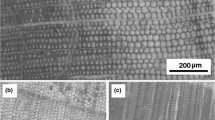Abstract.
Heat and stable isotope tracers were used to study axial and radial water transport in relation to sapwood anatomical characteristics and internal water storage in four canopy tree species of a seasonally dry tropical forest in Panama. Anatomical characteristics of the wood and radial profiles of sap flow were measured at the base, upper trunk, and crown of a single individual of Anacardium excelsum, Ficus insipida, Schefflera morototoni, and Cordia alliodora during two consecutive dry seasons. Vessel lumen diameter and vessel density did not exhibit a consistent trend axially from the base of the stem to the base of the crown. However, lumen diameter decreased sharply from the base of the crown to the terminal branches. The ratio of vessel lumen area to sapwood cross-sectional area was consistently higher at the base of the crown than at the base of the trunk in A. excelsum, F. insipida and C. alliodora, but no axial trend was apparent in S. morototoni. Radial profiles of the preceding wood anatomical characteristics varied according to species and the height at which the wood samples were obtained. Radial profiles of sap flux density measured with thermal dissipation sensors of variable length near the base of the crown were highly correlated with radial profiles of specific hydraulic conductivity (k s) calculated from xylem anatomical characteristics. The relationship between sap flux density and k s was species-independent. Deuterium oxide (D2O) injected into the base of the trunk of the four study trees was detected in the water transpired from the upper crown after only 1 day in the 26-m-tall C. alliodora tree, 2 days in the 28-m-tall F. insipida tree, 3 days in the 38-m-tall A. excelsum tree, and 5 days in the 22-m-tall S. morototoni tree. Radial transport of injected D2O was detected in A. excelsum, F. insipida and S. morototoni, but not C. alliodora. The rate of axial D2O transport, a surrogate for maximum sap velocity, was positively correlated with the predicted sapwood k s and with tree height normalized by the relative diurnal water storage capacity. Residence times for the disappearance of the D2O tracer in transpired water ranged from 2 days in C. alliodora to 22 days in A. excelsum and were positively correlated with a normalized index of diurnal water storage capacity. Capacitive exchange of water between stem storage compartments and the transpiration stream thus had a profound influence on apparent rates of axial water transport, the magnitude of radial water movement, and the retention time in the tree of water taken up by the roots. The inverse relationship between internal water exchange capacity and k s was consistent with a trade-off contributing to stability of leaf water status through highly efficient water transport at one extreme and release of stored water at the other extreme.
Similar content being viewed by others
Author information
Authors and Affiliations
Additional information
Electronic Publication
Rights and permissions
About this article
Cite this article
James, S.A., Meinzer, F.C., Goldstein, G. et al. Axial and radial water transport and internal water storage in tropical forest canopy trees. Oecologia 134, 37–45 (2003). https://doi.org/10.1007/s00442-002-1080-8
Received:
Accepted:
Issue Date:
DOI: https://doi.org/10.1007/s00442-002-1080-8




